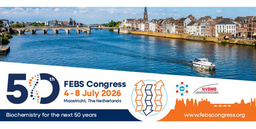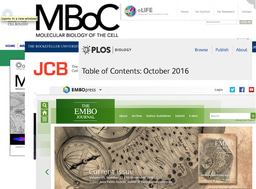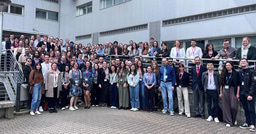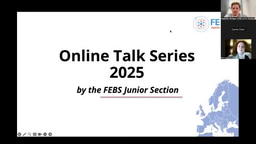FEBS Excellence Awardee spotlight: Mikolaj Ogrodnik

Mikolaj Ogrodnik is a group leader at the LBG-Senescence and Healing of Wounds (Vienna, Austria). He received his PhD at the Newcastle Institute for Ageing (UK) and did his post-doctoral research at the Mayo Clinic (Rochester, USA). His laboratory explores a wide range of subjects, including the early-onset responses of skin to injury, molecular basis of cell senescence, relationship between cytoskeletal proteins and cell migration, relationship between cellular senescence in situ and the ageing process, and engineering of artificial skin. He received a FEBS Excellence Award (funds for equipment/consumables for early-career group leaders) in 2022.
What is your current research focus?
My research background was focused on the process of ageing, particularly the accumulation of various damage forms in cells that induce their aged phenotype: cellular senescence. While my current research focus still includes ageing and cellular senescence, my laboratory also studies the processes of healing and regeneration. Specifically, my lab investigates how skin responds to damage or wounding and how to regenerate missing tissue to provide an outcome as similar to the original as possible. One exemplary discovery from my research team is the method of determining the volume of tissue that responds to damage and is involved in the healing process. With an injury, such as a cut or a needle prick, the skin needs to be involved in healing, but not too little or too much, just the right volume. Now, we can determine this volume using a set of molecular markers, as outlined in our recent publication, providing a sharp border to the part of skin involved in the process of healing [1]. Our follow-up projects aim to determine how animals manage to contain tissue damage upon injury and master the process of tissue regrowth. Additionally, we are researching the process of ageing and trying to figure out how we can trigger regeneration of damaged, dysfunctional or missing structures, body parts, or organs in an aged organism.
What’s exciting in this field at the moment?
The fields of research on ageing and regeneration/healing have remained rather separate so far. The former has focused on the role of cellular senescence and epigenetic modifications in ageing, with the dominant approaches to ameliorate ageing via drugs targeting growth pathways or senescent cells and recently with genetic interventions inducing stem-cell-like state of cells (pluripotency). The field of regeneration has been attempting to better understand how certain animals, such as axolotls, are able to regenerate lost tissue parts and why mammals are not able to do that. New methodologies, such as single-cell RNA sequencing and a broad range of genetic models, allow us to disseminate the molecular biology in charge of regeneration. The most exciting stage will be when the two fields start to merge so that we can utilize our knowledge on regeneration and healing to alleviate the tissue damage and dysfunction known to occur during ageing [2] .
What drew you to work in this area?
The process of ageing is one of the biggest mysteries scientists have been trying to solve. Processes such as development and homeostasis, while complex, are still tightly regulated. On the contrary, ageing seems to be primarily driven by factors unrelated to basic physiology, but the response to these that we refer to as the phenotype of ageing (how ageing looks like from the outside) encapsulates all the aspects of basic physiology, albeit twisted in numerous ways [3] . While the basic drivers of ageing are difficult to study or treat, we can modulate the responses to ageing that rely on physiology. With this, I wanted to link to the original question in two ways. First, for studying ageing we can and should study other aspects of human physiology and pathology as the pathways and processes relevant for one are also likely relevant for the other. There is a great promise in understanding wounding, healing and regeneration and linking these to ageing. Second, ageing contains all the conundrums and secrets of our body, homeostasis and pathology while at the same time being the core, if not the sole, driver of essentially all the major medical problems of the 21st century. I decided to study ageing as I believe I can add data, concepts, hypotheses and ideas of what ageing is – and if that adds anything to solving its complexity or finding new treatments against it, there wouldn’t be many better choices to make.
What would be your advice to PhD students and postdocs who would like to eventually start their own lab?
As an experimental researcher, it is important to realize your area of expertise and use it effectively to drive your research projects and collaborate with other researchers. It is also essential to utilize the strengths of your environment to enhance your research. While reliable and creative publications stand as the foundation for starting the lab, solid applications are needed for essential funding and on the top of that, knowing the field of research shows where and when to try/apply. Personally though, I like to think that the process of starting a lab comes down to doing high-quality science and is less to do with knowing people and/or systems. As far as I can say, dedication and unfaltering enthusiasm for research persisting over (quite many…) years naturally leads to starting a laboratory. However, one can realize that with these qualities one does not have to lead a lab to have a fulfilling life as a researcher.
What makes an effective research group?
A research group consists of a number of people who work on individual projects, making it tricky to define the effectiveness of a research group as the term matches better individual projects/work of individual researchers rather than of the whole group. Still, there is tons of room for helping to improve/maintain effectiveness of projects. In general, one can help the researchers by providing close attention and frequent discussion on the goals. These, I would say, should not be “carrot & stick” long-term promises of articles, applications, ground-breaking discoveries, but rather day-to-day experiments and their analysis. While it might sound less adventurous, it really adds not only to effectiveness but also to the reliability of experiments if the progress of research is driven primarily by the experimental results rather than some pre-made hypotheses. On the top of that, effective research needs things such as equipment, money, expertise of collaborators, technical assistance and so on, which can be summarized as providing resources and identifying and reducing barriers. While these are important, maybe even paramount, what makes an effective research group is guidance for each project through innumerable but individual data pieces to conclusions and findings.
What are your current/next goals?
My main next goals are solely scientific and I found it extremely interesting to explore and bring together the biology of healing, regeneration and ageing for the hope of revealing pathways linking those processes as well as manipulating them. In my opinion, by broadening our knowledge on regeneration and healing we can understand the phenotype of ageing and learn how to counteract it.
The reality is, however, that in order to achieve any of these we need sufficient funding and resources. There are early-stage researchers working with me and I want to provide them with the means to do research, to graduate and to publish reliable and innovative findings. Therefore, currently I am trying to divide my time and attention between writing applications and doing the fundamental science.
Relevant papers from my lab
1 Ring, N.A.R., Dworak, H. et al. (2023) The p-rpS6-zone delineates wounding responses and the healing process. Dev. Cell 58, 981–992.E6. https://doi.org/10.1016/j.devcel.2023.04.001
2 Ring, N.A.R., Valdivieso, K. et al. (2022) The role of senescence in cellular plasticity: Lessons from regeneration and development and implications for age-related diseases. Dev. Cell 57, 1083–1101. https://doi.org/10.1016/j.devcel.2022.04.005
3 Ogrodnik, M. and Gladyshev, V.N. (2023) The meaning of adaptation in aging: insights from cellular senescence, epigenetic clocks and stem cell alterations. Nat. Aging. https://doi.org/10.1038/s43587-023-00447-5
Top image of post: by Helene Dworak. Artistic visualization of p-rpS6-zone induction in wounded skin.





Join the FEBS Network today
Joining the FEBS Network’s molecular life sciences community enables you to access special content on the site, present your profile, 'follow' contributors, 'comment' on and 'like' content, post your own content, and set up a tailored email digest for updates.